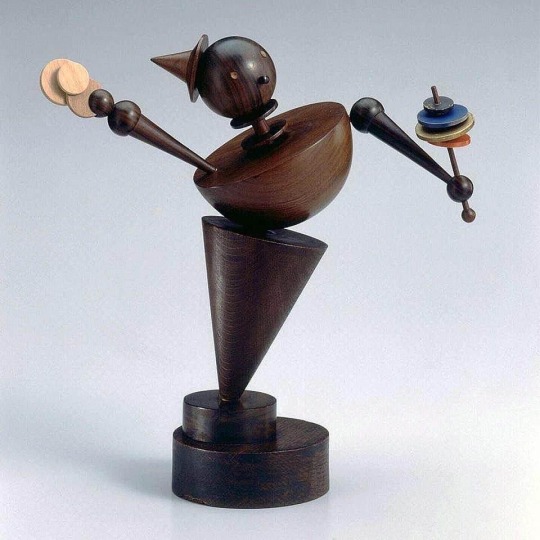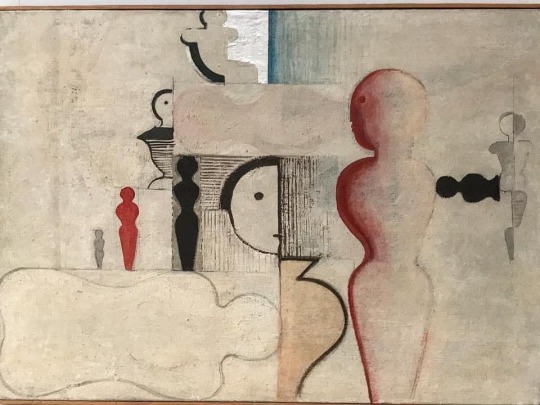#Oscar Schlemmer
Text
Pathologic and Edward Gordon Craig
In this episode, one very tired theatrology student will try to explain how Craig's ideas about actors and theatre in general might have factored into the way theatre is used in pathologic, especially when it comes to minor changes made between patho classic and 2. We'll talk about puppets vs actors, the role of directors and how it all relates to death. Yay!
SPOILERS FOR BOTH GAMES AHEAD
THEATRE IN PATHOLOGIC

So, anyone who's seen Codex Entry's video essays might be aware that Pathologic very visibly uses and plays with various theatrical ideas and concepts, especially when it comes to XXth century avantgarde movements. So far, Ruby has discussed the influences of Artaud (my boi), Brecht and Beckett, but today we're going to take a little step back and focus on one thinker who might have just been on of the most important theatre theorists ever and whose ideas definitely influenced all those that came after him. We're talking about our favorite theatre malcontent- Edward Gordon Craig

Soo, Craig was a theatre theoretician, actor, director, and founder of the magazine "The mask" back in the 1910s. In it, Craig would talk about his thoughts on theatre, which were largely counter-cultural, at least in comparison to the standard established back in the mid XIXth century. His works are often cited as fundamental to the Great Reform movement, which included among others, Stanislavsky, Reinhardt, and Appia. Their works paved the way towards avant garde theatre and a completely new understanding to it.
Now, why is Craig so important? Basically, he complained a lot and had very cool, albeit sometimes impossible ideas which were later inspired other in creative ways. His main ideas were:
Theatre is not a synthesis of other arts but rather something autonomical, unlike SOME OTHER PEOPLE THOUGHT (im loking at you wagner)
The director>>>>>>>> some dumb smelly actors
The actor shall one day be replaced by the Uber marrionette (tm)
Today we'll focus on those last two, since they are interconnected and most relevant in Pathologic.
The second point is pretty self-explanatory. Craig proposed that the director and their vision is the most important part of any given theatre show. The director should have a holistic vision, knowledge about all the arts participating in theatre and abilities to make their ideas reality. Before that, directors were more like the caretakers of shows, while the main focus was on the star actors. And this way of thinking leads us directly toooo:
THE UBER MARRIONETTE

(project by Oscar Schlemmer)
So, what is the uber marrionette? Basically it's a slightly esoteric idea that somewhere between puppets and living actors exists a form which would be perfectly responsive to the director's artistic vision. Human actors were ego-driven, restricted by their bodies and minds which generally not malleable enough to be a good material, even going so far as to suggest that acting is not an artform at all, since it is driven by chance and not specific intentions.
In contrast to that, Craig explained the nature of puppets- perfectly controlled, humble, objects of worship. And also symbols of death. Which he thought of as perfection. So, in some way, a perfect actor is a ...dead actor. Or, not literally dead, but posseing the perfect stasis of death, one usually assosciated with inanimate objects.
OK, WTF?
As I mentioned those ideas are very cool theories but are rather hard to actualize in the real world, especially since Craig was sometimes vague about what he ACTUALLY wanted to see. He would complain about people misinterpreting his works and declaring that he wants to replace actors with literal machines, while also never specifying what he actually meant. So different artists tried to bring his ideas to life, mostly by "mechanising" living actors, or using some blend of life and artificiality. In practice it was mostly shit like putting actors in giant metal pots and making them communicate in mono syllables to restrict their natural expressions od self as much as possible

OK, BUT HOW DOES THAT RELATE TO PATHOLOGIC?
So my theory is, that by portraying the player character(s) as puppets in classic, and as actors and tying all of this to the idea of death, the makers of PAthologic are playing (pun intended) with the concept of the uber marionnette and maybe even proposing a solution to this impossible problem.
Let's start with classic, because it's pretty straight forward. The characters are dolls/puppets (I'll be using those words interchangibly because fundamentally they serve the same purpose). The theatre itself is specifically said to host puppet shows (which is in itself a nod to the long standing tradition of folk puppetry in Russia and other eastern european countries)

Which in hindsight, are a direct reference to the fact that the very story you are playing is nothing more than a game/puppet performance hosted by in-world The Powers That Be and at the very top by the makers of Pathologic. In that way it is a very straight forward (but ultimately incorrect) use of the uber marionette- the player character is a humble vessel through which an idea is manifested. It's a puppet made out of polygons and lines of code instead of wood or felt. Your role as a player in this performance is two fold- you are both the puppeteer (the one who moves the dolls) and the spectator (because you are being told the story, not the other way around). What you are not is the Director- that role, personified by Mark Immortel and later by the Executor and Tragedian is out of reach for you. So, as you can see it's definitely using puppets, but not necessarily uber marrionetes.
AND THEN WE HAVE PATHO 2
So, the theatre inspirations in Patho 2 are a lot less...subtle than in classic, one of them being literally namedropping my boi Artaud's concept of the Theatre of Cruelty.

But what I want to focus on in this case is the seeming dissapearence of the puppet metaphor from the first game. You are no longer compared to a puppeteer moving a vessel, but to an actor inhabiting a role. A role which is in a way highly restrictive, since there are only four endings, and only two choices that actually impact what happens in the end (what you do with the documents, and whether you take the fellow travellers deal or not) You are faced with the idea that you are replacable, so your personal ego is not valuable to the director in universe and the game creators out of the universe. And finally, to make it even more interesting, you are in-universe faces with the neverending cycle of life and death, through the system of deaths having consequences/being part of the game's continuous timeline instead of just out of universe reloading. I think you might already see where i am going with this.
I THINK THAT THOSE TRAITS MAKE ARTEMY'S PORTRAYAL SIMILAR TO THE CONCEPT OF THE UBER MARRIONETTE
So not the concept itself, but something that heavily resembles the ideal version of what it could have been. Now, does it theory make perfect sense? No, but I thought it was a cool though experiment to do nontheless. The idea of an uber marionnette is onfusing theatrologists to this day, and many people have claimed to having founf a way to realize it, but since Craig himself was unclear about it, we will never know how relevan those tries were. But I still think that the topic of video games and theatre concepts is a fascinating one (that will probably be the topic of my bachelor's thesis lol), and pathologic is a perfect examples of those two ideas working together. If you have any other ideas about it, please let me know, and if you're interested i can make more posts about the theatrological angle of patho!!
134 notes
·
View notes
Text

Bauhaus Staircase
Oscar Schlemmer
• Painting, 1932
Arthive
75 notes
·
View notes
Text

Tadeusz Kantor next to the Goplana | Photo: Witold Witaliński
Goplana and the Elves
The exhibition evokes questions about the rank and status of objects. Goplana with Elves were not meant to be a decoration, but to “embody a stage character”. For Kantor, the object as a “form – a spatial sculpture with a metaphorical function” became an element of ambient art; arranging a space which is meant to “absorb” the viewer.
The object “Goplana and the elves” refers to the play “Balladine” which Tadeusz Kantor directed in 1943 in the Underground Independent Theatre. Unlike in Słowacki’s text, Kantor’s Goplana is not an ethereal nymph. The human figure has been replaced by a simplified, geometric form. The artist’s radical gesture shows a fascination with Constructivism and Bauhaus theater, especially Oscar Schlemmer’s “Triadic Ballet.” Such a departure from realism was also a result of the experience of the occupation and the associated dehumanization that disparaged the human figure.
No objects or props survived from the war. In the second half of the 1980s, with the Cricot 2 Theatre Museum in mind, Kantor began creating replicas of the objects that had not been preserved. They were supposed to evoke ideas that were important to him. “Goplana” was made of galvanized sheet metal and wood, which were the artist’s favourite materials. She is accompanied by two Elves made of light, openwork structures.
Curators: Małgorzata Paluch-Cybulska, Bogdan Renczyński
#Tadeusz Kantor#Goplana and the elves#Balladine#Underground Independent Theatre#Cricot 2 Theatre Museum#theatre#spatial sculpture
14 notes
·
View notes
Text
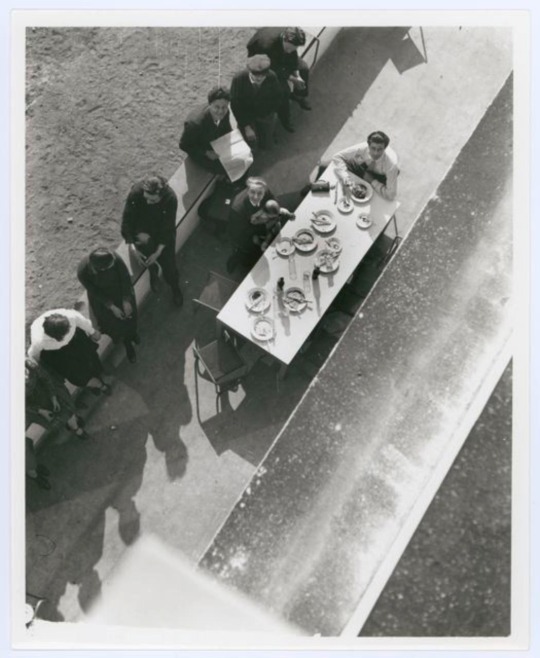
Irene Bayer (American, 1898 -1991) OSCAR SCHLEMMER AND T. LUX FEININGER WITH STUDENTS AT THE BAUHAUS, 1925- 1925
7 notes
·
View notes
Photo
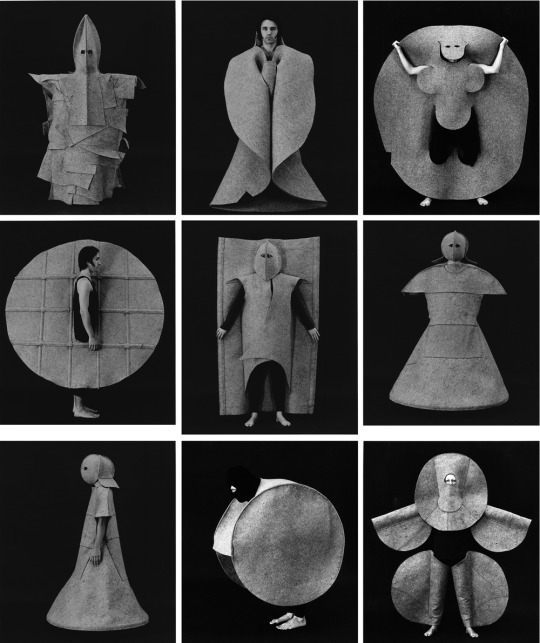
Ursula Sax (1935) Geometric ballet.
Homenaje a Oscar Schlemmer
88 notes
·
View notes
Text

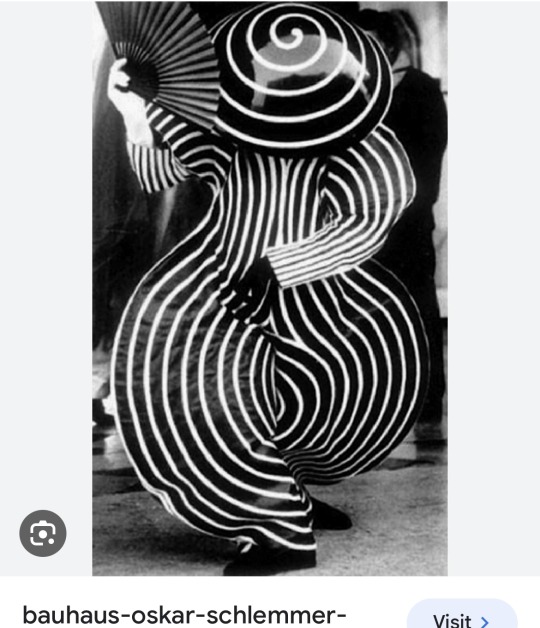

Always fascinated to see the connections tutors make when looking at my work. Thank you Peter Hofer for introducing me to Oscar Schlemmer.

0 notes
Text
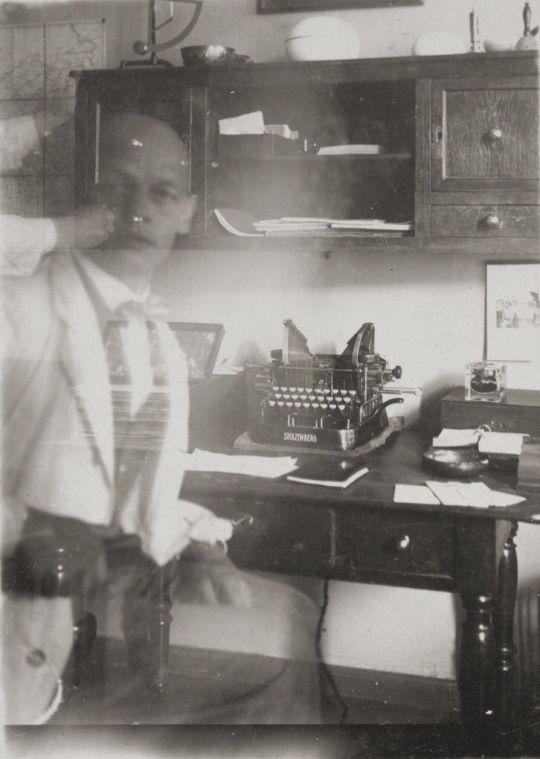
Autoritratto di Oskar Schlemmer presso Typewriter, Prellerstrasse Studio, 1925. Oscar è stato un pittore e scultore tedesco. Fin dal tempo della sua fondazione, aderì al Bauhaus di Weimar dirigendovi dal 1923 la sezione di cultura e teatro.
1 note
·
View note
Text
week 2~ performance lab
Over the weekend we set the task of creating a character for our performance/narrative. Before drawing anything up, I decided to research creatures and villains within Irish mythology to give me a base to create a villain character that links with the overall idea that we have decided on for our narrative. I found three main creatures that had the most potential to fit aesthetically into our project These are the Pooka, Famorians and the Sluagh. Upon looking further into each of these creatures, I decided the story behind the Sluagh would fit the most into the environment that we wanted to create. I then took elements from videos I watched on creating good character designs such as thinking about shapes (how they link to the characters personality, I selected curved shapes that ended in points to demonstrate femininity alongside a sharp end that would hint at the character's villain undertones), flow (simplify the design and have a focal point, I didn't want the dress to be overcomplicated with too many colours or textures), and threes (having three features/ items to draw attention to; I picked to have the wings, dress and makeup as the three in my design).I have picked up from research on character design to create what I think is a good first draft. (see below). This first draft was created digitally on an app called Procreate using an iPad and Apple Pencil. I also used inspiration from the mood board created last week.
Over the weekend, I also looked into Celtic knots as I thought they could be placed into the visuals of our performance, whether it was the set, lighting or character design. Specifically I think the shield knot (known for protection from spirits and opposing armies) and the trinity knot (known for the holy trinity and the christian church) would be most suited to the narrative of our project.
(Tuesday)
Firstly, Lara gave a presentation on visualising narratives. All of the examples given were new to me and I found them all very intriguing and different to anything I had seen before. The Triadic Ballet by Oscar Schlemmer was especially interesting to me as for a performance that was made In 1922, it seemed very modern in terms of design. After the session, I looked further into this ballet and found a video of the 1970s performance. The combination of music, costume and movement is just magnificent. Previously I had worried that the costumes would be awkward and restrictive from the image that Lara had included in her presentation however this was not the case as each character within the ballet was so personable and so distinctively Bauhaus, it created a beautiful piece of art that I felt was almost comedic.
Einstein on the beach had a similar feel to the triadic ballet. Both had emphasis on repetitive movements that were used to represent either the music or narrative. While there were some similarities, I didn't enjoy EoTB nearly as much as the Triadic Ballet. I think the performance choreography almost tried to hard to be "deep" or abstract. I feel as though the slower pacing of the performance was more difficult to stay engaged with also even though there were many things going on at the same time, I couldn't help feeling slightly bored by it. as it was based surrounding the idea of an actual person, different to the triadic ballet where the narrative was more on about the relationship between the set and music with completely new, never seen before ideas, the narrative was almost lost because as an audience member, I was more focused on how it related to Einstein and his life.
Es Devlin's explanation of her creative process was incredibly insightful and inspiring. Her way of creating so many iterative outcomes really reminded me of my A-level product design course but gave more ideas for once the design ideas had been narrowed down. Branching so many slightly different iterations from a singular idea really showed how small tweaks can make a difference to an outcome. Seeing her take those prototypes and turn them into a final piece backed up the idea of how circular the design process of anything is, no matter what stage you are at.
After our lecture, we were then off to our groups to continue working on our project. As our task for over the weekend was to create first drafts of our characters, we started off by presenting our work to the rest of the group, talking about why we had made certain design choices. This was a great task to complete in our own styles, away from each other as it meant each design was completely different from one another and could inspire each other when developing our ideas even further. We had Amie join our group so spent a small amount of time catching her up with what progress we had already made and what we had in mind for the next steps in our project. This lead to us honing in on a set narrative. Having designed our characters already was useful to create a plot and was more like connecting the dots between the characters. As we had already researched basic narrative structures, we could amalgamate the two together with little to no struggle. We also had to take into account the fact that our performance would only last 10 minutes so we would have to adjust the structure of the storyline to ensure it was engaging and satisfying. Our original idea for the plot was to have the characters of Amie, Hemza, Liz and Zoe to be in a church/ cathedral as a party (like dungeons and dragons games are regularly laid out). One of the characters would be injured, from a recent, previous battle. Zoe's character of the fairy would then leave all of the windows open (most emphasis on the west windows). It is unclear as of yet the reasoning behind her opening the windows, it is a very important plot point as this is what allows the sluagh villain entry into the cathedral. Next, we had two ideas for how the performance would end. Someone could be picked from the party to be sacrificed or one could have the ultimatum of having to pick between their powers or the deity they worship (this also links back to Zoe's dice and dungeons and dragons as the way some characters have super powers are because they worship a deity/ god).
Now that we knew what the narrative would be (settling on the sacrifice instead of the power vs god ending), we gave each member of the group a task to complete by Friday. Hemza would create all of our characters in a 3D AI style that would allow us to visualise them in greater detail. The rest of us would then focus on story boards to convey different elements of our performance. Zoe would do the story board containing the plot, I would do one based on sound, Liz would do one based on Lighting and Ashe would do one based on the set. Amie's task was to catch up with us and complete her own character design so that we would be able to include her object into the narrative. Because we knew we wouldn't have much time to complete this project, we were going to have to do most of the making/ researching outside of our Tuesday and Friday sessions in order to take advantage of the time we had together as a group, being able to discuss, explore different ideas and make important decisions together as a team.
The afternoon section to our day consisted of our first workshop with John Trevor. It was based mostly on collaboration and how to do this in a team setting. One of the points I took from the session was John's emphasis of not trying to be unique or think outside of the box. As an artist I find that this is something that we strive for, to create something different and innovative as if you just create something that Is the same as something else, there is no use for it. Whereas his view was that to collaborate affectively then you should go for the obvious which would make the team function a lot more smoothly.
(wednesday)
John returned on the Wednesday to give us a workshop that was still improv based but was directed more towards skills that could be used in a presentation. I found the day to be extremely useful as we were given different activities that made us aware of how we hold ourselves in front of an audience and how to think on our feet. We worked in a small group of 4 as that was how many people showed up to the session. It was definitely out of my comfort zone and I did feel slightly overwhelmed at certain points (specifically when doing the task where we were to narrate a fairytale and found it difficult to deliver a specific line in a sad way) John pushed me to try again and again in order to improve and as when you present to an audience you are putting yourself out there to be critiqued. When the session had finished, we had a group discussion with John about what we thought/ found useful from the day. As a group the one thing we all agreed on was the "colour, emotion, advance" tactic was extremely useful in order to engage the audience in whatever narrative we were using as a base. I feel as though this would be a great tool to use when creating the script for our performance.
(friday)
Our reading for the week was one extract about audience, and another about space. Again, there were very few that had read the text so the discussion wasn't in great depth but the main points that I had taken from extract about audience and spectator was that a performance is determined by its audience and how they interpret it. Some are aimed at a certain demographic however most theatre pieces want the widest audience possible.
The Friday session for my group was on the quieter side as everyone was either late or absent. Hemza went through the method he used to create his versions of each of our characters. This was using an AI generator called Art Breeder.
After our group tutorial and brief presentation to the class, it was evident that having 5/6 separate mannequins (one for each character) would be impractical and too time consuming based on our strict timescale so we had reduced this back to two separate ones. One would be a combined mannequin of Zoe, Hemza, Liz and Amie's characters and the other would be a stand alone of my character. We decided on dividing it this way as after looking into audience placement on the blueprint of the studio, we wanted to have the combined mannequin within the black space and the villain mannequin outside of the space. An issue that had been raised about this would be how to use the lighting design on the mannequin outside of the black space. Light projection would be less visible as there is a lot of natural lighting in our studio. This will require experimentation and research of different light methods to see with is the most suitable for our needs. So far we have thought of regular overhead lighting that is attached to the black box's frame, use of mini projectors for spotlights and projection mapping.
As I had the sound story board, I took samples of each of our objects to import into GarageBand and started to experiment with the midi keyboard to create a soundtrack for our performance. This would be mostly to create atmosphere and build an immersive experience.




1 note
·
View note
Photo

Irene Bayer
- Bauhaus Stage (Oscar Schlemmer costumes)
1927
105 notes
·
View notes
Photo

Woman with a mask by Schlemmer seated in one of Marcel Breuer’s first tubular steel chairs
[::SemAp Twitter || SemAp::]
#BW#Black and White#Preto e Branco#Noir et Blanc#黒と白#Schwarzweiß#retro#vintage#Oscar Schlemmer#mask#Marcel Bruer#steel chair
224 notes
·
View notes
Photo

1925, Oscar Schlemmer, Escalier de femmes
181 notes
·
View notes
Photo

Oskar Schlemmer
Bauhaus 1-3, 1927
181 notes
·
View notes


